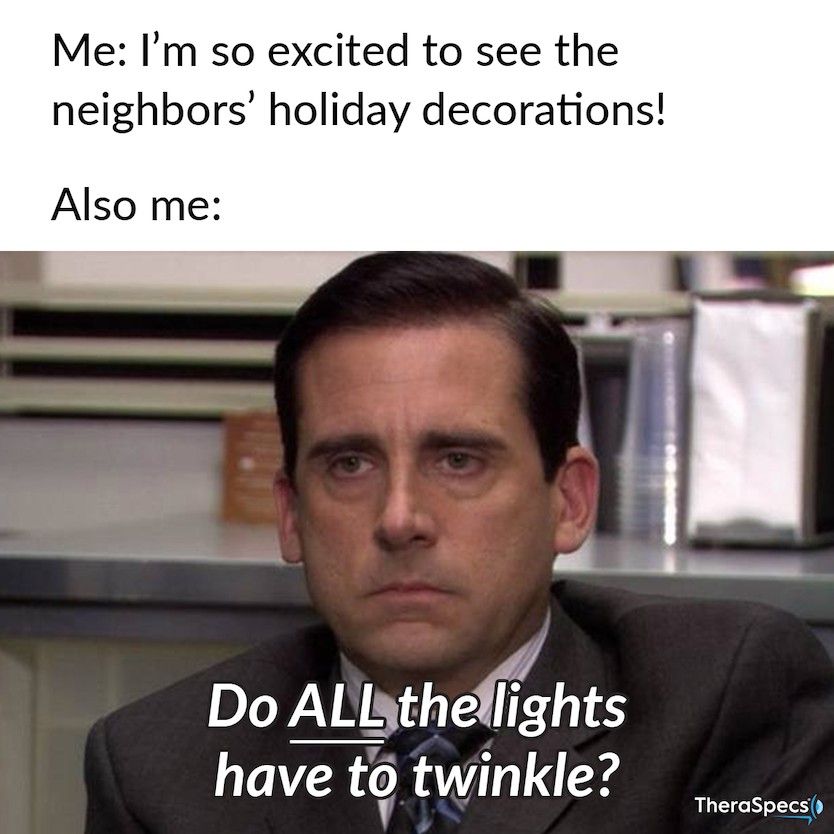All Is Bright: How LED Christmas Lights Can Hurt Light-Sensitive Eyes
The holiday season fills so many all over the United States and around the world with cheer, but it can also fill light-sensitive people with dread, and sometimes pain, on account of Christmas and holiday lighting, especially LEDs. Here are five reasons why these often bright, colorful and at times extravagant displays can hurt the eyes and brains of those susceptible to light.
They often flicker and flash
Even the most basic of holiday LED lighting setups have visible flickering effects—offering a fun spin on static Christmas displays but also posing a risk for light-sensitive individuals. For instance, many with migraine have negative responses to flashing lights, in large part because of the sensory dysfunction that contributes to how their eyes and brains process light. The effect of movement of the lighting can further harm a person with vestibular disorders and/or motion sensitivity. Now imagine being exposed to those intricate lighting showpieces that feature hundreds, even thousands, of timed lights that flash rapidly! They sure do look cool, but only if your eyes can stand them for more than a few seconds of viewing.

They are best viewed at night
It’s no secret that to enjoy the full effect of Christmas lights, you generally want to view them after dark or in low-light environments. However, this creates a stark contrast between the surrounding dim space and the brightness that hits the eyes; this is well established to negatively impact those with migraine, among other light-sensitive conditions. A similar effect occurs with LED car headlights that pierce the darkness at night and cause pain for people with photophobia. It is that jarring light-dark disparity that can be overwhelming.
They are doused with blue light
Artificial light, and especially LEDs, can have higher concentrations of blue light, even if the holiday lights themselves don’t appear blue to the eye. And of course, this spectrum of visible light can have profound effects on our health, with very specific wavelengths—the most harmful ones—even activating specific cells in the eyes of sensitive persons. This trips the proverbial wires in the brain, leading to an avalanche of symptoms that ranges from headaches to eye pain and dizziness.
They are literally inescapable
During the Christmas season, specialty LED displays permeate our streets, our shops, and the homes of our family and friends who celebrate it. Even if you make your best effort, it can be difficult to avoid them. Not only does this increase the odds that you might be surprised with bright light exposure, but there is a greater likelihood of trigger “stacking” too. This means that even if you can bypass one moment of exposure to holiday lighting, the repeated subjection to it will eventually get to you by lowering the threshold of what your brain can handle—thus leading to the onset of pain and other symptoms.
They reflect off so many surfaces
Although not unique to LEDs, Christmas lights reflect off a variety of surfaces. So even if you cut out the direct brightness, you might be hit by the reflection. And shiny surfaces, like metal or jewelry, may be some of the biggest offenders. Even snow or wet surfaces, which can cover the ground during the winter months, can reflect these lights and harm sensitive eyes.
Tips for Protecting Yourself
Knowing the reasons why LED Christmas/holiday lights can cause problems for your health is all well and good, but it is better if you have strategies for keeping yourself protected against these negative effects. Here are a few ways to manage your exposure while still enjoying the holiday spirit.
Opt for static lights: You may not be able to control others’ lighting selections, but you can control your own. Choosing single-color, static display lights (or making those the default settings) will limit your exposure in the home to their flashing or flickering complications.
Focus on ambient light: Rather than dimming LED lights, which can exacerbate the inherent nonvisual “flicker” (which can be just as harmful as a visible flicker), boost ambient lighting indoors to create a more balanced environment for your eyes and brain.
Try therapeutic blue light glasses: You might be tempted to wear sunglasses if you know you’ll be exposed to triggering Christmas lights, but they should only be a last resort. Instead, try blue light glasses like TheraSpecs that filter more of the harmful wavelengths and protect those with migraine, concussion and other light-sensitive disorders.
Plan your exposure in advance and during the day, if possible: Scoping out shops and neighborhoods that have LED holiday light-up displays before you have extended exposure—especially during the day when they might be less impactful—can help you plan for the best (and worst) case scenarios. You can even ask your friends and family if they’ll scout the locations for you and report back on possible triggers.
Minimize other triggers: Trigger stacking is a real concern for patients, which makes it imperative to minimize other instigators if you can, such as stress (which is already high during the holidays). That way, you stand a fighting chance even if you are exposed to bright LED Christmas lights.
Hopefully these tips can bring more of the brightness of the holidays into your life without the discomfort it may have caused in years past.
TheraSpecs Glasses for Light Management
Try our light-filtering glasses and stay protected against harsh light from screens, fluorescents, LEDs, unwanted blue light, bright sunlight, flashing lights, and more.





